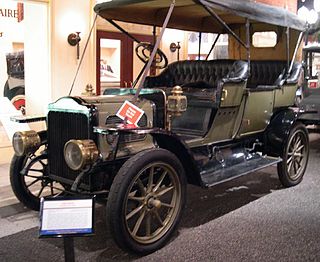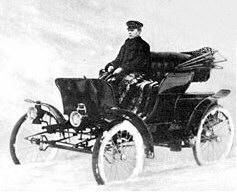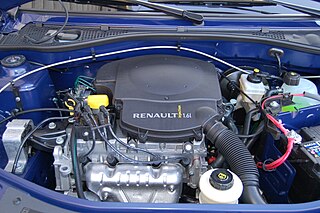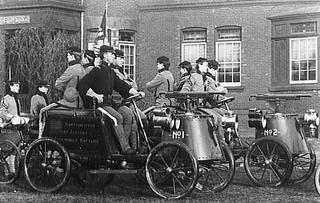The White Motor Company was an American automobile, truck, bus and agricultural tractor manufacturer from 1900 until 1980. The company also produced bicycles, roller skates, automatic lathes, and sewing machines. Before World War II, the company was based in Cleveland, Ohio. White Diesel Engine Division in Springfield, Ohio, manufactured diesel engine generators, which powered U.S. military equipment and infrastructure, namely Army Nike and Air Force Bomarc launch complexes, and other guided missile installations and proving grounds, sections of SAGE and DEW Line stations, radars, Combat Direction Centers and other ground facilities of the U.S. aerospace defense ring, such as the Texas Towers.
Grand Prix motor racing, a form of motorsport competition, has its roots in organised automobile racing that began in France as early as 1894. It quickly evolved from simple road races from one town to the next, to endurance tests for car and driver. Innovation and the drive of competition soon saw speeds exceeding 100 miles per hour (160 km/h), but because early races took place on open roads, accidents occurred frequently, resulting in deaths both of drivers and of spectators. A common abbreviation used for Grand Prix racing is "GP" or "GP racing".

Ransom Eli Olds was a pioneer of the American automotive industry, after whom the Oldsmobile and REO brands were named. He claimed to have built his first steam car as early as 1887 and his first gasoline-powered car in 1896. The modern assembly line and its basic concept is credited to Olds, who used it to build the first mass-produced automobile, the Oldsmobile Curved Dash, beginning in 1901.

The Brass Era is an American term for the early period of automotive manufacturing, named for the prominent brass fittings used during this time for such things as lights and radiators. It is generally considered to encompass 1896 through 1915, a time when these vehicles were often referred to as horseless carriages.

A steam car is a car (automobile) propelled by a steam engine. A steam engine is an external combustion engine (ECE) in which the fuel is combusted outside of the engine, unlike an internal combustion engine (ICE) in which fuel is combusted inside the engine. ECEs have a lower thermal efficiency, but carbon monoxide production is more readily regulated.

In automotive use, the Stanhope is a car body style characterized by its single bench seat mounted at the center, folding cloth top, and a dashboard at the front. These vehicles were built from approximately 1900 to 1910. The design was derived from the Stanhope horse-drawn carriage and could be considered a specific type of runabout.

Woods Motor Vehicle Company was an American manufacturer of electric automobiles in Chicago, Illinois, between 1899 and 1916. In 1915 they produced the Dual Power with both electric and internal combustion engines which continued until 1918.

Development of the automobile started in 1672 with the invention of the first steam-powered vehicle, which led to the creation of the first steam-powered automobile capable of human transportation, built by Nicolas-Joseph Cugnot in 1769. Inventors began to branch out at the start of the 19th century, creating the de Rivas engine, one of the first internal combustion engines, and an early electric motor. Samuel Brown later tested the first industrially applied internal combustion engine in 1826.

As of 2013, there were a wide variety of propulsion systems available or potentially available for automobiles and other vehicles. Options included internal combustion engines fueled by petrol, diesel, propane, or natural gas; hybrid vehicles, plug-in hybrids, fuel cell vehicles fueled by hydrogen and all electric cars. Fueled vehicles seem to have the advantage due to the limited range and high cost of batteries. Some options required construction of a network of fueling or charging stations. With no compelling advantage for any particular option, car makers pursued parallel development tracks using a variety of options. Reducing the weight of vehicles was one strategy being employed.

A car is a wheeled motor vehicle that is used for transportation. Most definitions of cars say that they run primarily on roads, seat one to eight people, have four wheels, and mainly transport people instead of goods.

The Davidson Automobile Battery armored car was a further development of the Davidson-Duryea gun carriage, but with steam power. It was built by Royal Page Davidson and the cadets of the Northwestern Military and Naval Academy in Highland Park, Illinois. Davidson designed this vehicle in 1901. He and his students at the Northwestern Military and Naval Academy built two of these partially armored military vehicles. They were armed with Colt .30 caliber machine guns. The vehicles were powered by a tubular steam boiler. They had difficulty in going up hills because of changes of the water level in the boiler. Davidson made these lightly armored military vehicles of one thousand pounds at the Academy campus in Highland Park, Illinois. These two partially armored military vehicles were labeled No. 1 and No. 2. Presently No. 2 is at the Chicago Museum of Science and Industry.
Two Brass era automobiles named Richmond were produced in Richmond, Indiana. A Steam car was made by the Richmond Automobile Company in 1902 and 1903. The Wayne Works produced the Richmond automobile from 1904 to 1917.

The Waltham Steam was an American steam car.
Century Motor Vehicle Company (1899–1903) was a manufacturer of electric and steam automobiles in Syracuse, New York. The company switched to gasoline-fuelled internal combustion engine-powered automobiles in January 1903, and went out of business later that year.
Clipper and Michigan were the name of an early steam car built in Grand Rapids, Michigan in 1901 and 1902.
This is a chronological index for the start year for motor vehicle brands. For manufacturers that went on to produce many models, it represents the start date of the whole brand; for the others, it usually represents the date of appearance of the main model that was produced.










